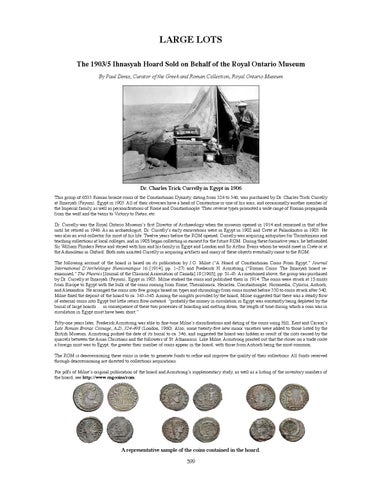LARGE LOTS The 1903/5 Ihnasyah Hoard Sold on Behalf of the Royal Ontario Museum By Paul Denis, Curator of the Greek and Roman Collection, Royal Ontario Museum
Dr. Charles Trick Currelly in Egypt in 1906 This group of 6533 Roman bronze coins of the Constantinian Dynasty, dating from 324 to 346, was purchased by Dr. Charles Trick Currelly at Ihnasyah (Fayum), Egypt in 1903. All of their obverses have a head of Constantine or one of his sons, and occasionally another member of the Imperial family, as well as personifications of Rome and Constantinople. Their reverse types promoted a wide range of Roman propaganda from the wolf and the twins to Victory to Pietas, etc. Dr. Currelly was the Royal Ontario Museum’s first Director of Archaeology when the museum opened in 1914 and remained in that office until he retired in 1946. As an archaeologist, Dr. Currelly’s early excavations were in Egypt in 1902 and Crete at Palaiokastro in 1903. He was also an avid collector for most of his life. Twelve years before the ROM opened, Currelly was acquiring antiquities for Torontonians and teaching collections at local colleges, and in 1905 began collecting in earnest for the future ROM. During these formative years, he befriended Sir William Flinders Petrie and stayed with him and his family in Egypt and London and Sir Arthur Evans whom he would meet in Crete or at the Ashmolean in Oxford. Both men assisted Currelly in acquiring artifacts and many of these objects eventually came to the ROM. The following account of the hoard is based on its publication by J.G. Milne (“A Hoard of Constantinian Coins From Egypt,” Journal International D’Archéologie Numismatique 16 [1914], pp. 1–27) and Frederick H. Armstrong (“Roman Coins: The Ihnasyah hoard reexamined,” The Phoenix [Journal of the Classical Association of Canada] 19 [1965], pp. 51–9). As mentioned above, the group was purchased by Dr. Currelly at Ihnasyah (Fayum), Egypt in 1903. Milne studied the coins and published them in 1914. The coins were struck at 15 mints from Europe to Egypt with the bulk of the coins coming from Rome, Thessalonica, Heraclea, Constantinople, Nicomedia, Cyzicus, Antioch, and Alexandria. He arranged the coins into five groups based on types and chronology from coins minted before 330 to coins struck after 340. Milne fixed the deposit of the hoard to ca. 343–345. Among the insights provided by the hoard, Milne suggested that there was a steady flow of external coins into Egypt but little return flow outward: “probably the money in circulation in Egypt was constantly being depleted by the burial of large hoards…. in consequence of these two processes of hoarding and melting down, the length of time during which a coin was in circulation in Egypt must have been short.” Fifty-one years later, Frederick Armstrong was able to fine-tune Milne’s classifications and dating of the coins using Hill, Kent and Carson’s Late Roman Bronze Coinage, A.D. 324-498 (London, 1960). Also, some twenty-five new minor varieties were added to those listed by the British Museum. Armstrong pushed the date of its burial to ca. 346, and suggested the hoard was hidden as result of the riots caused by the quarrels between the Arian Christians and the followers of St. Athanasius. Like Milne, Armstrong pointed out that the closer on a trade route a foreign mint was to Egypt, the greater their number of coins appear in the hoard, with those from Antioch being the most common. The ROM is deaccessioning these coins in order to generate funds to refine and improve the quality of their collections. All funds received through deaccessioning are directed to collections acquisitions. For pdfs of Milne’s original publication of the hoard and Armstrong’s supplementary study, as well as a listing of the inventory numbers of the hoard, see http://www.cngcoins/rom.
A representative sample of the coins contained in the hoard. 599
